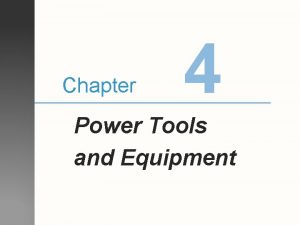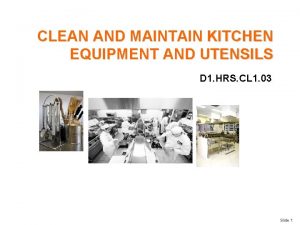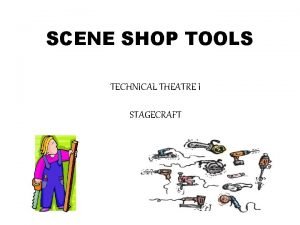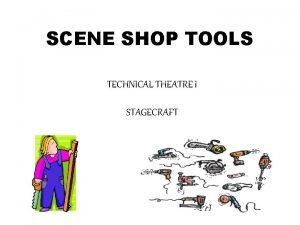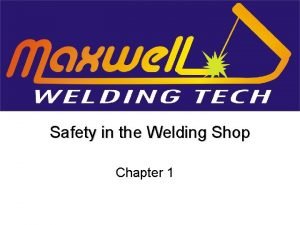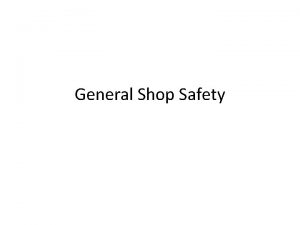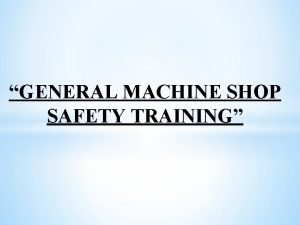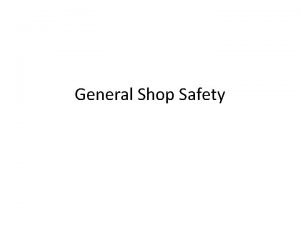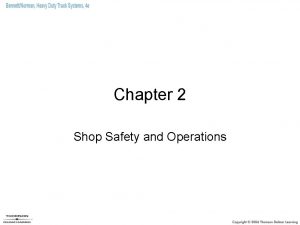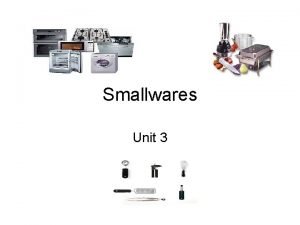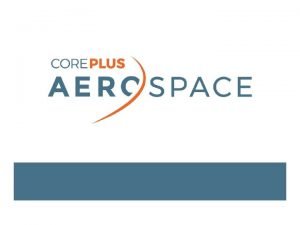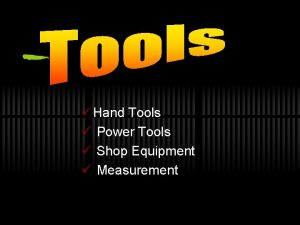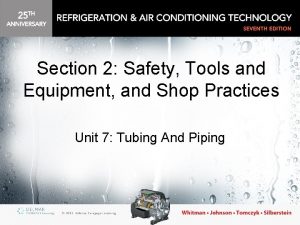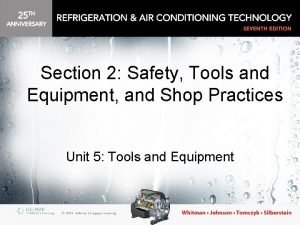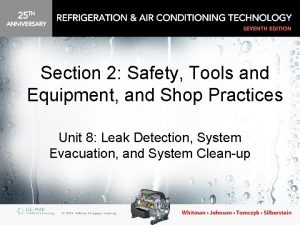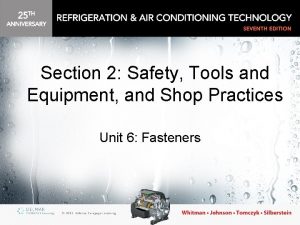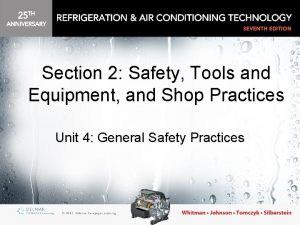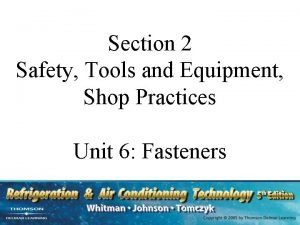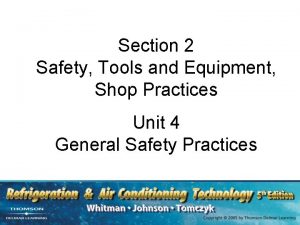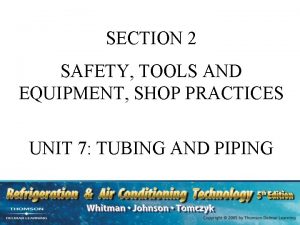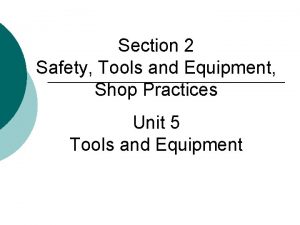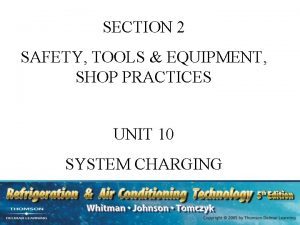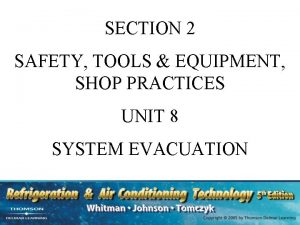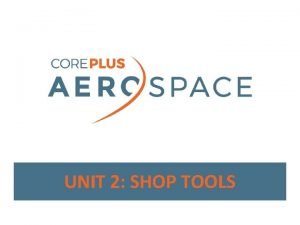Section 2 Safety Tools and Equipment and Shop




















- Slides: 20

Section 2: Safety, Tools and Equipment, and Shop Practices Unit 10: System Charging

Objectives • After studying this unit, you should be able to: – Describe how refrigerant is charged into systems in the vapor and liquid states – Describe system charging using two different weighing methods – State the advantage of using electronic scales for weighing refrigerant into a system •

Objectives (cont’d. ) – Describe two types of charging devices – Charge refrigerant blends incorporating a temperature glide and fractionation potential – Charge fixed orifice, capillary tube, and piston (short tube) air-conditioning systems using charging charts and curves

Objectives (cont’d. ) – Use the subcooling method of charging to charge air-conditioning and heat pump systems that incorporate a thermostatic expansion valve (TXV) as the metering device – Use modern temperature/pressure charts that incorporate dew point and bubble point values for calculating subcooling and superheat amounts

Charging a Refrigeration System • Correct charge must be added for a refrigeration system to operate as designed • Added by weighing, measuring, or using operating pressures • Carefully monitor evaporator superheat, condenser subcooling, operating pressures, and compressor amperage

Vapor Refrigerant Charging • Vapor can be added to the high- and low-pressure sides of the system while it is not operating – Vapor can be added to the low-pressure side of the system while it is operating – The cylinder may need to be warmed to build up pressure to charge the system • Warm water can be used; never use a torch

Figure 10– 2 The temperature of the cylinder is 95°F. The pressure inside the cylinder is 114 psig. The low-side pressure is 20 psig.

Liquid Refrigerant Charging • When the system has been evacuated, liquid refrigerant can be added through the liquid line or receiver – Liquid charging is faster than vapor charging – The low-pressure control may need to be bypassed during the charging process

Liquid Refrigerant Charging (cont’d. ) • Liquid refrigerant can be charged into the low side of the system if the refrigerant has first been vaporized • When charging systems with blended refrigerants, the refrigerant must leave the cylinder as a liquid

Figure 10– 6 This system is being charged while it has no refrigerant in it. The liquid refrigerant moves toward the evaporator and the condenser when doing this. No liquid refrigerant will enter the compressor

Weighing Refrigerant • Weighing the correct charge can be accomplished with an electronic scale – Bathroom scales should not be used – Electronic scales are often used • Expensive but very accurate • Automatically displays amount of refrigerant removed from cylinder • Some units dispense a predetermined amount of refrigerant and then shut off

Using Charging Devices • Graduated cylinders – Used to add refrigerant to smaller systems – Affected by ambient temperature – A pressure gauge gives the saturation pressure and temperature of the refrigerant • Other charging devices are available – Use pressure or weight

Using Charging Charts • Curves and/or charts supplied by manufacturers – Used to help properly charge systems – Charts and curves vary for manufacturer to manufacturer – Uses superheat values – Charge carefully! • It is always easier to add refrigerant than remove it

Subcooling Method of Charging For TXV Systems Figure 10– 22 The subcooling charging method for a high-efficiency split R-410 A air-conditioning system with a TXV metering device

Charging Near-Azeotropic (Zeotropic) Refrigerant Blends • Blended refrigerants – Have different properties than component refrigerants – Azeotropic blends • Have only one saturation temperature for each pressure – Near-azeotropic (zeotropic) blends • Temperature glide when they evaporate or condense

Charging Near-Azeotropic (Zeotropic) Refrigerant Blends (cont’d. ) • Dew point value – Where saturated vapor begins to condense – Used for superheat calculations • Bubble point values – Where saturated liquid begins to boil – Used for subcooling calculations

Charging Near-Azeotropic (Zeotropic) Refrigerant Blends (cont’d. ) • Fractionation – Part of the blend will evaporate or condense before the rest of the blend – Will not occur when the refrigerant is liquid • The component of the blend with the lowest boiling point will leak faster • Refrigerant must leave the cylinder as a liquid

Summary • Evaporator superheat, condenser subcooling, and compressor amperages should be monitored when charging an air conditioning or refrigeration system • Refrigerant can be added to a system in either the vapor or liquid state • Liquid charging is faster than vapor charging

Summary (cont’d. ) • Refrigerant charges can be weighed into the system • Charging charts can be used to determine the proper system charge • Azeotropic blends behave as single refrigerants • Near-azeotropic blends have a temperature glide

Summary (cont’d. ) • Temperature glide indicates that there is more than one saturation temperature at a given pressure • Blended refrigerants must leave as liquid • The dew point is where vapors begin to condense • Bubble point is where liquids begin to vaporize
 Chapter 4 power tools and equipment
Chapter 4 power tools and equipment Flow shop definition
Flow shop definition 7 cleaning and maintaining kitchen premises
7 cleaning and maintaining kitchen premises Tech theatre tools
Tech theatre tools Tech theatre tools
Tech theatre tools Welding shop safety test
Welding shop safety test Get shop safe .com
Get shop safe .com Get shop safe .com
Get shop safe .com General shop safety
General shop safety Shop safety colors
Shop safety colors General shop safety
General shop safety Pinch point safety definition
Pinch point safety definition Shop safety colors
Shop safety colors Auto shop safety
Auto shop safety Welding shop safety
Welding shop safety Machine shop safety checklist
Machine shop safety checklist Unit 4 personal safety in agricultural mechanics
Unit 4 personal safety in agricultural mechanics General shop safety
General shop safety General ventilation
General ventilation Chapter 2 safety practices
Chapter 2 safety practices Difference between tools and equipment
Difference between tools and equipment
